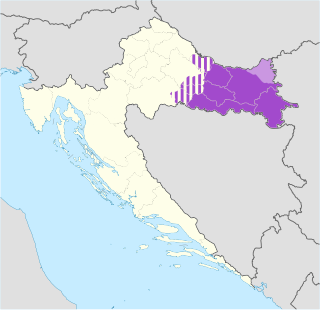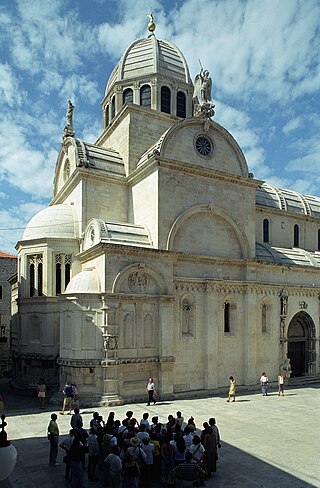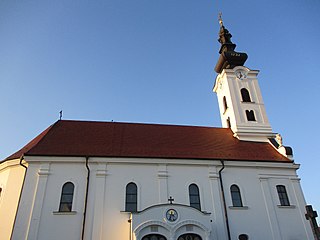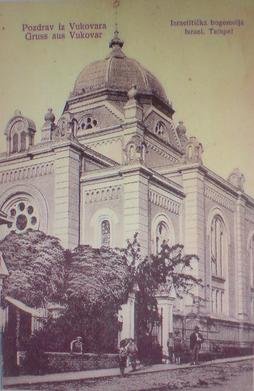
Slavonia is, with Dalmatia, Croatia proper, and Istria, one of the four historical regions of Croatia. Taking up the east of the country, it roughly corresponds with five Croatian counties: Brod-Posavina, Osijek-Baranja, Požega-Slavonia, Virovitica-Podravina, and Vukovar-Syrmia, although the territory of the counties includes Baranya, and the definition of the western extent of Slavonia as a region varies. The counties cover 12,556 square kilometres or 22.2% of Croatia, inhabited by 806,192—18.8% of Croatia's population. The largest city in the region is Osijek, followed by Slavonski Brod and Vinkovci.

Vukovar is a city in Croatia, in the eastern regions of Syrmia and Slavonia. It contains Croatia's largest river port, located at the confluence of the Vuka and the Danube. Vukovar is the seat of Vukovar-Syrmia County and the second largest city in the county after Vinkovci. The city's registered population was 22,616 in the 2021 census, with a total of 23,536 in the municipality.

Vukovar-Srijem County, Vukovar-Sirmium County or Vukovar-Syrmia County, named after the eponymous town of Vukovar and the region of Syrmia, is the easternmost Croatian county. It includes the eastern parts of the region of Slavonia and the western parts of the region of Syrmia, as well as the lower Sava river basin, Posavina and Danube river basin Podunavlje. Due to the overlapping definitions of geographic regions, division on Slavonia and Syrmia approximately divides the county vertically into north-west and south-east half, while division on Posavina and Podunavlje divides it horizontally on north-east and south-west half.

The šajkača is the Serbian national hat or cap. Traditionally worn by men in the Serbian countryside, it is named after Serb river troops known as šajkaši. A popular national symbol in Serbia since the beginning of the 20th century, it is typically black, grey or green in colour and is usually made of soft, homemade cloth. It became widely worn by Serb men beginning in the 1880s and was a key component in the uniform of the Serbian military from the end of the 19th century. Today, it is mostly worn by elderly men in rural communities.

Borovo, also known as Borovo Selo, is a village and a municipality in Vukovar-Syrmia County in eastern part of Croatia. Situated on the banks of the Danube river, it shares its border with Serbia and the municipality of Bač on the opposite side. The historical development of Borovo is intricately linked with the Danube, which has played a pivotal role in its development as a notable industrial hub in the region.

The Battle of Vukovar was an 87-day siege of Vukovar in eastern Croatia by the Yugoslav People's Army (JNA), supported by various paramilitary forces from Serbia, between August and November 1991. Before the Croatian War of Independence the Baroque town was a prosperous, mixed community of Croats, Serbs and other ethnic groups. As Yugoslavia began to break up, Serbia's President Slobodan Milošević and Croatia's President Franjo Tuđman began pursuing nationalist politics. In 1990, an armed insurrection was started by Croatian Serb militias, supported by the Serbian government and paramilitary groups, who seized control of Serb-populated areas of Croatia. The JNA began to intervene in favour of the rebellion, and conflict broke out in the eastern Croatian region of Slavonia in May 1991. In August, the JNA launched a full-scale attack against Croatian-held territory in eastern Slavonia, including Vukovar.

The Croatian War of Independence was fought from 1991 to 1995 between Croat forces loyal to the Government of Croatia—which had declared independence from the Socialist Federal Republic of Yugoslavia (SFRY)—and the Serb-controlled Yugoslav People's Army (JNA) and local Serb forces, with the JNA ending its combat operations in Croatia by 1992. In Croatia, the war is primarily referred to as the "Homeland War" and also as the "Greater-Serbian Aggression". In Serbian sources, "War in Croatia" and (rarely) "War in Krajina" are used.
The Vukovar massacre, also known as the Vukovar hospital massacre or the Ovčara massacre, was the killing of Croatian prisoners of war and civilians by Serb paramilitaries, to whom they had been turned over by the Yugoslav People's Army (JNA), at the Ovčara farm southeast of Vukovar on 20 November 1991, during the Croatian War of Independence. The massacre occurred shortly after Vukovar's capture by the JNA, Territorial Defence (TO), and paramilitaries from neighbouring Serbia. It was the largest massacre of the Croatian War of Independence.

Eltz Manor is a Baroque palace in Vukovar, Croatia. The 18th-century manor is the location of the Vukovar City Museum. The manor, as it previously appeared, was depicted on the reverse of the Croatian 20 kuna banknote, issued in 1993 and 2001. The palace suffered substantial damages and destruction in 1991 during the Croatian War of Independence. However, after four years of restorations, it was completely restored to its pre-war appearance in October 2011.

The architecture of Croatia has roots in a long history: the Croats have inhabited the area for fourteen centuries, but there are important remnants of earlier periods still preserved in the country.
The Velepromet camp was a detention facility established in the final days of the Battle of Vukovar during the Croatian War of Independence. The camp was set up by the Yugoslav People's Army (JNA), which shared control of the facility with Croatian Serb rebels. The facility, originally an industrial storage site, was located on the southern outskirts of the city of Vukovar, in close proximity to the JNA barracks. It consisted of eight warehouses surrounded by a wire fence, and was established on 16 November 1991, when the first detainees were brought there.

Split, historically known as Spalato, is the second-largest city of Croatia after the capital Zagreb, the largest city in Dalmatia and the largest city on the Croatian coast. It lies on the eastern shore of the Adriatic Sea and is spread over a central peninsula and its surroundings. An intraregional transport hub and popular tourist destination, the city is linked to the Adriatic islands and the Apennine Peninsula. More than 900,000 tourists visit Split each year.

Foreign relations between Croatia and Serbia are bound together by shared history, language and geography. The two states established diplomatic relations in 1996, following the dissolution of Yugoslavia, the Croatian War of Independence and the independence of Croatia. Modern diplomatic relations are functional but cold, stemming from historic nation-building conflict and divergent political ideologies. Their relationship holds geopolitical importance in Southeast Europe given their economic influence in the region.

The Croatian War of Independence was fought from 1991 to 1995 between Croat forces loyal to the government of Croatia—which had declared independence from the Socialist Federal Republic of Yugoslavia (SFRY)—and the Serb-controlled Yugoslav People's Army (JNA) and local Serb forces, with the JNA ending its combat operations in Croatia by 1992.
The Battle of Osijek was the artillery bombardment of the Croatian city of Osijek by the Yugoslav People's Army (JNA) which took place from August 1991 to June 1992 during the Croatian War of Independence. Shelling peaked in late November and December 1991, then diminished in 1992 after the Vance plan was accepted by the combatants. Airstrikes and attacks by JNA infantry and armored units against targets in the city accompanied the bombardment, which caused approximately 800 deaths and resulted in a large portion of the city's population leaving. Croatian sources estimated that 6,000 artillery shells were fired against Osijek over the period.

Church of St. Nicholas in Vukovar is a Serbian Orthodox church in eastern Croatia. The church is one of the oldest baroque buildings of the Serb community north of the Sava River.

Vukovar Synagogue was the main synagogue of the Jewish community in Vukovar, Croatia, after the first smaller synagogue was sold to the Calvinist church in 1910. It was constructed in 1889 in the Kingdom of Croatia-Slavonia, within the Austria-Hungary.

The Serbs of Vukovar are one of traditional communities living in the multicultural, multi-ethnic and multi-confessional eastern Croatian town of Vukovar on the border with Serbia. The Serb community constitutes slightly over one third of the entire population of Vukovar according to 2011 Census. Other significant communities include the Croat majority, as well as Hungarians, Slovaks, Rusyns, Ukrainians and historically Yugoslavs, Germans, Jews, Vlachs and Turks.

Remembrance Day or Day of Remembrance for the Victims of the Homeland War and Day of Remembrance for the Victims of Vukovar and Škabrnja it is a national public holiday in the Republic of Croatia and a non-working day in memory of all victims of the Homeland War in Croatia. The holiday is celebrated on November 18, the day of the fall of the city of Vukovar in the 1991 Homeland War, when the Yugoslav People's Army and Serbian paramilitaries committed the two most massive crimes in Croatia during the Croatian War of Independence in two Croatian towns, Vukovar and Škabrnja. These events are known as Vukovar massacre and Škabrnja massacre. In memory of these events, the Croatian Parliament in 2019 has adopted a new law which introduced a new holiday, a day of remembrance for all victims of the Croatian War of Independence.
The 1991 killings of Serbs in Vukovar were a series of incidents in which Serbs living in and around Vukovar during the spring and summer of 1991 were subject to kidnappings and summary executions by armed thugs associated with the Croatian National Guard. These events began as the Croatian War of Independence was starting, prior to the start of the Battle of Vukovar in August of the same year. After the war, some criminal investigations were undertaken, including one of the notable perpetrators Tomislav Merčep, though on the whole the matter remains largely unresolved.


















